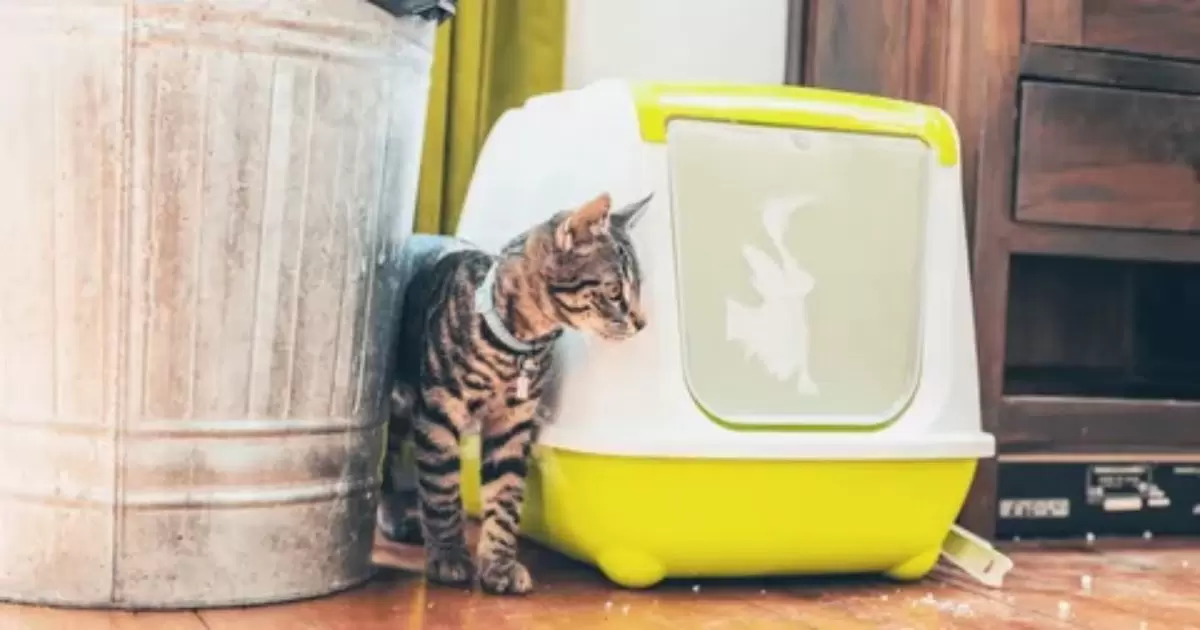Transitioning a cat to a covered litter box involves gradually introducing them to a box with a hood, door, or other cover. This process aims to shift the cat’s behavior to accept and regularly use the new enclosed space for their bathroom needs. It requires patience, positive reinforcement, and careful monitoring while the cat adapts.
How To Transition Cat To Covered Litter Box? Making the switch to a covered cat litter box can be tricky but is often necessary to contain mess, provide privacy, or keep babies and toddlers safe. While cats tend to resist change, you can set them up for success. Strategies like incremental exposure, rewards, managing stress signals, and providing backup relieve anxiety so kitty embraces their new facilities.
When embarking on covered litter box training, start by obtaining an additional box so your cat always has access. Place the uncovered and covered side by side first. Let the kitty explore while praising and treating for any interest shown. Over days/weeks, move the uncovered box away while ensuring they use the covered one. Remain alert to signs of stress. With time, positive association, and patience, your cat can thrive in their new setup.
Benefits of a Covered Litter Box
A covered litter box offers several advantages. It helps contain mess and odor inside the enclosed space. The cover provides privacy that some cats prefer for doing their business. It also keeps dogs and babies out.
An enclosed field helps restrict the unfolding of muddles that can arise with an open tray.
Preparing for the Transition
Properly preparing for introducing a covered litter box helps ease the adjustment period. Obtain an extra open litter box and place it side-by-side with the existing one before transition. Let your cat use both for a while so they don’t lose access to a familiar option. This allows them to check out the new covered box without feeling forced into it right away.
Obtain an Extra Litter Box
Getting an extra litter box is recommended when transitioning to a covered option. Put the new covered box next to the old open one at first. Let your cat explore and use either box freely. The additional open tray ensures your cat still has a familiar bathroom available during the gradual covered box introduction process.
Place Both Boxes Side-by-Side Initially
Initially placing uncovered and covered litter boxes side-by-side allows for a smooth adjustment period. Your cat can investigate and use the new covered option without losing access to their old open tray. Keeping both options easily available prevents forcing an abrupt switch and lowers stress. Over time, once they regularly utilize the covered version, you can remove the backup open box.
Making the New Box Familiar
When transitioning a cat to a brand new litter container, it can help to make the new container appear more acquainted. Place the brand new litter field after the old one for some days so the cat can sniff and explore it. You may even sprinkle a small amount of used clutter from the antique box into the new one so it smells greater familiar. This can help the cat feel comfortable with the new box more quickly.
Add Familiar Litter
When introducing a brand new kind of muddle in conjunction with a new muddle container, make sure to combine some of the cat’s antique, acquainted muddle with the new muddle. Cats can be very particular approximately the fragrance and texture of their muddle.
Adding a decent quantity of the previous muddle enables the brand-new litter to appear much less overseas and surprising.
Over time, you can transition to only using the new litter. But keeping some familiar scent helps make the change less abrupt.
Allow Plenty of Exploration Time
It’s crucial no longer to hurry a cat whilst introducing new objects into their environment. Provide adequate possibility for them to explore a brand new litter box on their phones. Place the new box in an easily accessible spot and resist any urge to forcefully move or guide the cat into the box.
Let them sniff, paw, and investigate the box as needed to become comfortable. Give encouragement and treats for any interest shown. With patience and time to explore, the cat is likely to eventually try out the new box.
Gradually Introducing the New Covered Box
When transitioning your cat to a brand new protected muddle box, it’s vital to take things slowly. Start with the aid of placing the new covered field after the vintage one, with the lid off. This allows your cat to get used to the new box itself first.
Over a week or two, move the boxes farther apart while encouraging your cat to use the new ones. Once your cat is regularly using the new uncovered box, you can start introducing the lid in short increments, building up to leaving it closed.
First Introduce an Uncovered New Box
The first step when introducing a covered litter box is to present it without the lid at first. Simply place the uncovered new box next to your cat’s old litter box. This allows them to get accustomed to the shape, size, and location of the new box without also having to deal with an enclosed space right away. As your cat gets comfortable using the open new box, you can then move to the next step of gradually adding the cover.
Slowly Incorporate the New Box Cover
After a few days of your cat using the new uncovered box, place the cover nearby so your cat starts to associate it with the new box. Over the next week or so, gradually move the cover closer, starting by just leaning it against the box, then partially covering the entrance, then finally fully covering it. This step-by-step process allows gradual adjustment.
Supporting Your Cat During the Transition
Transitioning to a blanketed muddle container can be stressful for cats. Be patient and offer rewards when they use the new box. Try placing treats or catnip inside to encourage them. Avoid punishment or forcing them into the new box.
Keep the old box available during the process. Pay attention to signs of stress like hiding or bathroom accidents. If needed, slow down the transition timeline based on your cat’s comfort level. With time and positive reinforcement, your cat can adapt to the new covered setup.
| Step | Action |
| 1 | Place the uncovered new box next to the old box |
| 2 | Encourage the use of new uncovered box |
| 3 | Introduce the lid next to the new box |
| 4 | Lean lid against new box during use |
| 5 | Gradually move the lid over the new box |
| 6 | Begin closing the lid for short periods |
| 7 | Reward and support the cat throughout the process |
FAQ’s
Should I immediately put the lid on the newly covered litter box?
No, first permit your cat to get used to the brand-new exposed container before gradually putting the lid on over days or perhaps weeks.
What if my cat refuses to use the new covered litter box?
Go back to an earlier step in the transition process. Also try rewards, keeping their old box available, or modifying the entrance/exit size if too small.
How long does it take cats to transition to a covered litter box?
It depends on the cat, but expect the process to take 1-2 months. Go at your cat’s pace and don’t rush the transition.
Where should I position the brand-new covered litter box?
Place it properly next to your cat’s old clutter container at the beginning so that they can find it easily and realize it’s intended for them.
How can I make a covered litter box transition easier on my cat?
Take it slow, use rewards and encouragement, never punish them, keep their old box handy, observe them for signs of stress, and adjust the process as needed.
Conclusion
The key to successfully transitioning your cat to a covered litter box is taking a gradual approach. Start by placing an uncovered new box next to their old one. Over time, slowly move the boxes farther apart as your cat uses the new one. Introduce the lid in increments, first leaning it on the box, then partially covering the entrance.
Reward your cat throughout the process. Avoid rushing or forcing them. With steady positive reinforcement and incremental steps, your cat can adjust to the new covered box. Patience and letting your cat set the pace leads to the smoothest transition.












